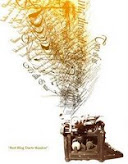If you’re about to complete this project in celebration of Dr. Seuss’ birthday, you have read Happy Birthday to You!. So you know what Dr. Seuss would do on his birthday if he could do anything in the whole world. What would you do?
Supplies Needed:
White Paper
Pencil
Markers
 Dr. Seuss’ picture book illustrations were completed in pen and ink, so let’s use markers for our illustrations. The result will be pretty close.
Dr. Seuss’ picture book illustrations were completed in pen and ink, so let’s use markers for our illustrations. The result will be pretty close.
Think about what you would do if you lived in Katroo and could have any wish in the world on your birthday. I would have a party on a pair of hot air balloons.
Draw your birthday adventure. Remember, you can celebrate with imaginary creatures or travel to anyplace in your imagination. It’s all up to you.
When you’re happy with your drawing, color it in with marker. You’ll want to outline most things in black first. If you look at Dr. Seuss’ drawings, he outlines in black, too.
 Finally, write a few rhyming lines about your birthday adventure.
Finally, write a few rhyming lines about your birthday adventure.
If you and your friends each create a page, you can put them together into your own birthday book.
Happy Birthday to You!
_____
Supplies Needed:
White Paper
Pencil
Markers
 Dr. Seuss’ picture book illustrations were completed in pen and ink, so let’s use markers for our illustrations. The result will be pretty close.
Dr. Seuss’ picture book illustrations were completed in pen and ink, so let’s use markers for our illustrations. The result will be pretty close.Think about what you would do if you lived in Katroo and could have any wish in the world on your birthday. I would have a party on a pair of hot air balloons.
Draw your birthday adventure. Remember, you can celebrate with imaginary creatures or travel to anyplace in your imagination. It’s all up to you.
When you’re happy with your drawing, color it in with marker. You’ll want to outline most things in black first. If you look at Dr. Seuss’ drawings, he outlines in black, too.
 Finally, write a few rhyming lines about your birthday adventure.
Finally, write a few rhyming lines about your birthday adventure.If you and your friends each create a page, you can put them together into your own birthday book.
Happy Birthday to You!
_____
Don't forget to Create Your Own Cat in the Hat Summary Hat!




 First, read Dr. Seuss’ The Cat in the Hat. Write a sentence each about the beginning, the rising action, the climax, the falling action, and the conclusion. You’ll use this later when you write your summary.
First, read Dr. Seuss’ The Cat in the Hat. Write a sentence each about the beginning, the rising action, the climax, the falling action, and the conclusion. You’ll use this later when you write your summary. Cut out five strips of red construction paper and lay them across your white hat in stripes. Glue down the left end of each strip. Remember to press down on the glued section for about ten seconds before you move on to the next strip. Trim the extra red paper.
Cut out five strips of red construction paper and lay them across your white hat in stripes. Glue down the left end of each strip. Remember to press down on the glued section for about ten seconds before you move on to the next strip. Trim the extra red paper.
 Write the title of the book and the author's name on the brim of the hat.
Write the title of the book and the author's name on the brim of the hat. It’s completely up to you what you want to draw. Maybe you want to combine a hippo with a canary. Maybe you want to draw a dog that can breathe underwater. Maybe you’ll create something completely new that no one has ever heard of before. It’s completely up to you.
It’s completely up to you what you want to draw. Maybe you want to combine a hippo with a canary. Maybe you want to draw a dog that can breathe underwater. Maybe you’ll create something completely new that no one has ever heard of before. It’s completely up to you. Now color your drawing using oil pastels. Because oil pastel smears pencil, your artwork will come out much cleaner if you don’t color straight onto the pencil drawing.
Now color your drawing using oil pastels. Because oil pastel smears pencil, your artwork will come out much cleaner if you don’t color straight onto the pencil drawing. Continue to play with the pastels until you are happy with your creation. If you and several of your friends are all creating imaginary creatures, you might think about cutting out your animals and using a glue stick to attach them to one background page. Then you’ll have a forest full of creatures!
Continue to play with the pastels until you are happy with your creation. If you and several of your friends are all creating imaginary creatures, you might think about cutting out your animals and using a glue stick to attach them to one background page. Then you’ll have a forest full of creatures! Cover your workspace.
Cover your workspace. Cover your entire boomerang with paint. Let it dry, then hang it and enjoy!
Cover your entire boomerang with paint. Let it dry, then hang it and enjoy! Like any time you paint, cover your workspace before you begin.
Like any time you paint, cover your workspace before you begin. Now add in details and patterns. You may wish to paint stripes onto your animal, or triangles and dots onto the background. (Q-tips are great for making dots.) This is the fun part so go crazy. If you need some inspiration, look at this
Now add in details and patterns. You may wish to paint stripes onto your animal, or triangles and dots onto the background. (Q-tips are great for making dots.) This is the fun part so go crazy. If you need some inspiration, look at this  Hang your bark painting and enjoy!
Hang your bark painting and enjoy!








 Let your tissue paper dry. Eric Carle recommends using this time to paint more sheets of tissue paper in different colors. I only used one sheet but you may want more than one pattern or color. Your tissue paper will need to dry for about 30 minutes.
Let your tissue paper dry. Eric Carle recommends using this time to paint more sheets of tissue paper in different colors. I only used one sheet but you may want more than one pattern or color. Your tissue paper will need to dry for about 30 minutes. I used four colors but you may decide to use only three or try five. It’s all up to you and your imagination. Just remember to let your tissue paper dry after each new layer of paint.
I used four colors but you may decide to use only three or try five. It’s all up to you and your imagination. Just remember to let your tissue paper dry after each new layer of paint. When your finished tissue paper is dry, trace hearts of different sizes onto your paper. Try to fit as many hearts as you can. Carefully cut out the hearts.
When your finished tissue paper is dry, trace hearts of different sizes onto your paper. Try to fit as many hearts as you can. Carefully cut out the hearts. Choose construction paper, fold it in half, and cut it into two cards. Repeat until you have as many cards as you wish to make.
Choose construction paper, fold it in half, and cut it into two cards. Repeat until you have as many cards as you wish to make. Repeat until you have decorated all of your cards.
Repeat until you have decorated all of your cards.


